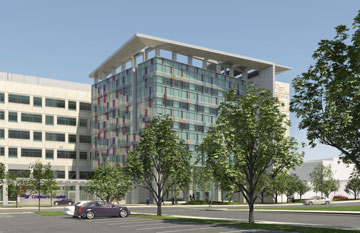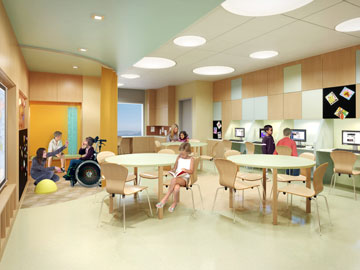Architectural Firm Aims for Zero Toxins

SAN FRANCISCO — In California, Proposition 65 requires all commercial buildings containing chemicals recognized by the state to cause cancer and birth defects to display signs warning anyone about to enter that “this area contains chemicals known to the State of California to cause cancer and birth defects or other reproductive harm.”
So wouldn’t it be stupid to build a hospital out of materials that harbor those chemicals? Wouldn’t it be even more stupid to build a hospital exclusively focused on treating cancer, birth defects and reproductive damage that harbors those chemicals? Most would agree it would be — yet it’s how hospitals are built every day.
When the design team at Anshen + Allen, a healthcare design firm in San Francisco, began work in 2007 on the University of California new hospital in the city’s Mission Bay neighborhood — a cancer hospital that will also treat childhood birth defects and adult reproductive problems when it opens in late 2014 — it realized how counterproductive it would be to design a facility for those types of patients that would necessitate the Prop. 65 sign in the first place. So the company, in conjunction with teams at McDonough Braungart Design Chemistry, and McDonough & Partners, MBDC’s design architecture arm, embarked on a mission to design the state’s first 100 percent toxin-free hospital by screening every building material that could possibly go in to the structure for its potential to cause those conditions.
“The realization that toxins within the building, especially carcinogens, would be an issue definitely hit home with the team, especially because [the hospital] is treating cancer,” says Tyler Krehlik, senior associate at Anshen and leader of the firm’s design team working on the hospital.
Although UCSF told Anshen that it wanted to integrate sustainability into its new hospital, it left the execution up to the team, says Krehlik. “One of the university’s stated missions is to improve health worldwide, and they had an opportunity with this building to deal with health issues. That is where the interest came from; it started as a big idea.”
While there is ample research and consensus on which chemicals are carcinogenic, there is little and conflicting research on which chemicals can be classified as Teratogens, which cause birth defects, and mutagens, which cause defects in embryonic DNA, says Krehlik.
With 10,000 materials that can go in to a hospital and the need to review the research on each understudied chemical to make a balanced decision as well as to compare multiple materials to determine the ones with the lowest toxicity, the Anshen and McDonough teams realized the screening process would take longer and cost more than the project’s timeframe or budget allowed. So they developed a set of criteria to determine which chemicals to screen. The criteria targeted chemicals: 1. listed on the California Proposition 65 list, 2. classified as known carcinogens, 3. classified as known Teratogens, 4. listed on the US Environmental Protection Agency’s list of “Chemicals of Concern,” 5. known to damage the adult reproductive system.

The teams also developed three filters — contact, repetition and spillover — to lower the number of building materials to research. In terms of contact, the teams needed to determine whether a person would be likely to touch, smell, lick, or chew on the material and in turn absorb potentially toxic chemicals through their mucous membranes — an important consideration in a children’s hospital. In terms of repetition, they considered the fact that inpatient and exam rooms are traditionally repeated in hospitals, so they “looked for repetition and the economy of scale that comes with it,” says Krehlik. Lastly, spillover considered the fact that materials used in inpatient and exam rooms are usually also used in the surrounding hallways, nurse’s stations, and other areas.
Ultimately, the criteria reduced the number of materials in the screen from 10,000 to a manageable 130.
Under EPA guidelines, manufacturers are not obligated to disclose ingredients in the product formulas that can be considered proprietary, so the teams resorted to Material Safety Data Sheets and other public information to ferret out the ingredients missing from the MSDS. They then created a scoring system to rank comparable materials. The system “deducted points for every known toxin in a product, weighted by an estimate of the percentage of the material’s content that was toxic and the severity of the toxin,” Krehlik says.
The teams were astonished to discover that the toxic chemicals tend to be in the additives rather than in what they were added to. Antimicrobials and stain-resistant finishes applied to carpets were toxic while the carpets themselves were not, for instance. “It changed the way we think about product selections,” says Krehlik. “[Now] we pick products or surfaces that don’t have or don’t need the additives, like linoleum.”
Yet, after all their effort, the Anshen and McDonough teams found that it is impossible to design a toxin-free building in the current market. Some materials, such as epoxy paints, do not have any high-scoring options, so Anshen was forced to choose the best available option, even if it had scored low. “That was a bit of a blow to us but we can at least try to do what we can,” says Krehlik.
But the trend toward thinking about the long-term impacts of buildings on human health seems to be on the upswing. The U.S. Green Building Council announced in early November its new Chemical Avoidance in Building Materials pilot credit, an acknowledgment of the health dangers certain chemicals pose to building inhabitants. The pilot credit currently focuses on phthalates [added to plastics to increase its flexibility, transparency, durability, and longevity] and flame retardants — rewarding project teams for avoiding materials composed of them — and will likely expand the list of chemicals as the council reviews the results of the pilot.
“I really think our work on the rating system for health care was originally for [the Chemical Avoidance in Building Materials pilot credit],” says Whit Falconer, director of LEED Technical Development at the USGBC. “Any time you are talking about building a green building the issue of green products comes up but the health care [committee] pushed this idea for a while. They had a lot of specific issues with regard to pathways to exposure for people with compromised immune systems that made it especially unique and important and pilot credit seemed like a reasonable place to talk about them.”
Bill Walsh, executive director of the Healthy Building Network, wrote in the organization’s recent newsletter that “this credit, along with an earlier credit for PBT Source Reduction: Dioxins and Halogenated Organic Compounds, marks the beginning of a three-step approach the USGBC is developing to address ‘chemicals of concern’ in building materials.”
But Walsh warned that the pilot credit could produce backlash. “LEED project teams will pay a critical role in the success of this process, which is likely to be aggressively resisted by the chemicals and plastics industries, and some product manufacturers,” he wrote.
Krehlik has the battle scars to prove it. During the UCSF materials screen he says he had “a bunch of [telephone] hang-ups, amazingly a lot” from manufacturers hostile to Anshen and McDonough’s project. “They start to worry about liability concerns and they don’t want to talk,” he says.
Falconer agrees, revealing that the USGBC has so far received the most pushback on the pilot credit from chemicals manufacturers. But he believes even they might be starting to see the light on producing non-toxic building materials.
“They are reserving judgment and giving us a little elbow room,” he says. “They’re seeing that this may not be end of the world and that it may be a transformative step.”
“In general, a lot of people seem to trust the council that the path we are choosing will be the path that facilitates the market,” Falconer added.
Meanwhile, Anshen is advancing the industry’s efforts to design healthier buildings by integrating the knowledge it gained from its UCSF screen in to its other projects. “It was a big ‘aha’ for us,” he says of the discovery that additives can be the major culprits. “We’ve rolled that into our design syncing — we’ve taken the data collected and it has allowed us to make better product selections on other projects.”
Will UCSF’s new Mission Bay hospital be the most non-toxic commercial building in California once it opens its doors to the public? “We hope so,” says Krehlik. “That is definitely our goal, but whether we’ll make it or not is an unknown.”
It’s safe to say it very likely will be.
